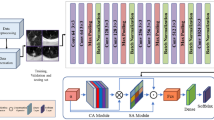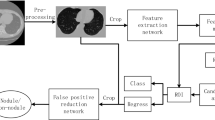Abstract
Detection of suspicious pulmonary nodules from lung CT scans is a crucial task in computer-aided diagnosis (CAD) systems. In recent years, various deep learning-based approaches have been proposed and demonstrated significant potential for addressing this task. However, existing deep convolutional neural networks exhibit limited long-range dependency capabilities and neglect crucial contextual information, resulting in reduced performance on detecting small-size nodules in CT scans. In this work, we propose a novel end-to-end framework called LGDNet for the detection of suspicious pulmonary nodules in lung CT scans by fusing local features and global representations. To overcome the limited long-range dependency capabilities inherent in convolutional operations, a dual-branch module is designed to integrate the convolutional neural network (CNN) branch that extracts local features with the transformer branch that captures global representations. To further address the issue of misalignment between local features and global representations, an attention gate module is proposed in the up-sampling stage to selectively combine misaligned semantic data from both branches, resulting in more accurate detection of small-size nodules. Our experiments on the large-scale LIDC dataset demonstrate that the proposed LGDNet with the dual-branch module and attention gate module could significantly improve the nodule detection sensitivity by achieving a final competition performance metric (CPM) score of 89.49%, outperforming the state-of-the-art nodule detection methods, indicating its potential for clinical applications in the early diagnosis of lung diseases.
Graphical abstract







Similar content being viewed by others
References
Chen W, Li Z, Bai L, Lin Y (2011) Nf-kappab in lung cancer, a carcinogenesis mediator and a prevention and therapy target. Frontiers in Bioscience-Landmark 16(3):1172–1185
Setio AA, Jacobs C, Gelderblom J, van Ginneken B (2015) Automatic detection of large pulmonary solid nodules in thoracic ct images. Medical physics 42(10):5642–5653
Nithila EE, Kumar S (2017) Automatic detection of solitary pulmonary nodules using swarm intelligence optimized neural networks on ct images. Engineering science and technology, an international journal 20(3):1192–1202
Lee Y, Hara T, Fujita H, Itoh S, Ishigaki T (2001) Automated detection of pulmonary nodules in helical ct images based on an improved template-matching technique. IEEE Transactions on medical imaging 20(7):595–604
Li Y, Zhang K, Shi W, Miao Y, Jiang Z (2021) A novel medical image denoising method based on conditional generative adversarial network. Computational and Mathematical Methods in Medicine 2021:1–11
Lei Y, Zhang J, Shan H (2021) Strided self-supervised low-dose ct denoising for lung nodule classification. Phenomics 1:257–268
Suji RJ, Bhadouria SS, Dhar J, Godfrey WW (2020) Optical flow methods for lung nodule segmentation on lidc-idri images. Journal of Digital Imaging 33:1306–1324
Vasiliuk A, Frolova D, Belyaev M, Shirokikh B (2022) Exploring structure-wise uncertainty for 3d medical image segmentation. arXiv:2211.00303
Sineglazov V, Klanovets O, Riazanovskiy K (2022) Transitive transfer learning for lungs ct segmentation. In: 2022 IEEE 3rd International conference on system analysis & intelligent computing (SAIC), IEEE, pp 1–5
Balachandran S, Ranganathan V (2023) Semantic context-aware attention unet for lung cancer segmentation and classification. International Journal of Imaging Systems and Technology 33(3):822–836
Zhang J, Xia K, Huang Z, Wang S, Akindele RG (2023) Etam: Ensemble transformer with attention modules for detection of small objects. Expert Systems with Applications 224:119997
Lin F-Y, Chang Y-C, Huang H-Y, Li C-C, Chen Y-C, Chen C-M (2022) A radiomics approach for lung nodule detection in thoracic ct images based on the dynamic patterns of morphological variation. European Radiology 32(6):3767–3777
de Mesquita VA, Cortez PC, Ribeiro AB, de Albuquerque VHC (2022) A novel method for lung nodule detection in computed tomography scans based on boolean equations and vector of filters techniques. Computers and Electrical Engineering 100:107911
Jin H, Li Z, Tong R, Lin L (2018) A deep 3d residual cnn for false-positive reduction in pulmonary nodule detection. Medical physics 45(5):2097–2107
Wang J, Wang J, Wen Y, Lu H, Niu T, Pan J, Qian D (2019) Pulmonary nodule detection in volumetric chest ct scans using cnns-based nodule-size-adaptive detection and classification. IEEE access 7:46033–46044
Wu K, Peng B, Zhai D (2022) Multi-granularity dilated transformer for lung nodule classification via local focus scheme. Applied Sciences 13(1):377
Lin J, She Q, Chen Y (2023) Pulmonary nodule detection based on ir-unet++. Medical & Biological Engineering & Computing 61(2):485–495. https://doi.org/10.1007/s11517-022-02727-5
Armato SGr, McLennan G, Bidaut L, McNitt-Gray MF, Meyer CR, Reeves AP, Zhao B, Aberle DR, Henschke CI, Hoffman EA, Kazerooni EA, MacMahon H, Van Beeke EJR, Yankelevitz D, Biancardi AM, Bland PH, Brown MS, Engelmann RM, Laderach GE, Max D, Pais RC, Qing DPY, Roberts RY, Smith AR, Starkey A, Batrah P, Caligiuri P, Farooqi A, Gladish GW, Jude CM, Munden RF, Petkovska I, Quint LE, Schwartz LH, Sundaram B, Dodd LE, Fenimore C, Gur D, Petrick N, Freymann J, Kirby J, Hughes B, Casteele AV, Gupte S, Sallamm M, Heath MD, Kuhn MH, Dharaiya E, Burns R, Fryd DS, Salganicoff M, Anand V, Shreter U, Vastagh S, Croft BY (2011) The lung image database consortium (lidc) and image database resource initiative (idri): a completed reference database of lung nodules on ct scans. Medical Phys 38(2):915–931
Li C, Zhu G, Wu X, Wang Y (2018) False-positive reduction on lung nodules detection in chest radiographs by ensemble of convolutional neural networks. IEEE Access 6:16060–16067
Gu J, Tian Z, Qi Y (2020) Pulmonary nodules detection based on deformable convolution. IEEE Access 8:16302–16309
Xie H, Yang D, Sun N, Chen Z, Zhang Y (2019) Automated pulmonary nodule detection in ct images using deep convolutional neural networks. Pattern Recognition 85:109–119
Zuo W, Zhou F, Li Z, Wang L (2019) Multi-resolution cnn and knowledge transfer for candidate classification in lung nodule detection. IEEE Access 7:32510–32521
Zhang J, Xia Y, Zhang Y (2018) A pulmonary nodule detection model based on progressive resolution and hierarchical saliency. arXiv:1807.00598 (2018)
Dosovitskiy A, Beyer L, Kolesnikov A, Weissenborn D, Zhai X, Unterthiner T, Dehghani M, Minderer M, Heigold G, Gelly S, Uszkoreit J, Houlsby N (2021) An image is worth 16x16 words: transformers for image recognition at scale. In: International conference on learning representations
Vaswani A, Shazeer N, Parmar N, Uszkoreit J, Jones L, Gomez AN, Kaiser L, Polosukhin I (2017) Attention is all you need. In: Proceedings of the 31st international conference on neural information processing systems. NIPS’17, pp 6000–6010
Devlin J, Chang M-W, Lee K, Toutanova K (2019) BERT: pre-training of deep bidirectional transformers for language understanding. In: Proceedings of the 2019 conference of the North American chapter of the association for computational linguistics: human language technologies, vol 1 (Long and Short Papers), pp 4171–4186. Association for Computational Linguistics, Minneapolis, Minnesota
Liu Z, Lin Y, Cao Y, Hu H, Wei Y, Zhang Z, Lin S, Guo B (2021) Swin transformer: hierarchical vision transformer using shifted windows. In: 2021 IEEE/CVF International conference on computer vision (ICCV), pp 9992–10002
Carion N, Massa F, Synnaeve G, Usunier N, Kirillov A, Zagoruyko S (2020) End-to-end object detection with transformers. In: Computer vision – ECCV 2020, Springer, Cham, pp 213–229
Zhu X, Su W, Lu L, Li B, Wang X, Dai J (2021) Deformable \(\{\text{detr}\}\): deformable transformers for end-to-end object detection. In: International conference on learning representations
Valanarasu JMJ, Oza P, Hacihaliloglu I, Patel VM (2021) Medical transformer: gated axial-attention for medical image segmentation. In: Medical Image Computing and Computer Assisted Intervention – MICCAI 2021, Springer, Cham, pp 36–46
Gao Y, Zhou M, Metaxas DN (2021) Utnet: a hybrid transformer architecture for medical image segmentation. In: Medical Image Computing and Computer Assisted Intervention – MICCAI 2021, Springer, Cham, pp 61–71
Han R, Liu X, Chen T (2022) Yolo-sg: salience-guided detection of small objects in medical images. In: 2022 IEEE International conference on image processing (ICIP), pp 4218–4222
Lee C-Y, Xie S, Gallagher P, Zhang Z, Tu Z (2015) Deeply-supervised nets. In: Proceedings of the eighteenth international conference on artificial intelligence and statistics. proceedings of machine learning research, PMLR, San Diego, California, USA, 38:562–570
Kundel H, Berbaum K, Dorfman D, Gur D, Metz C, Swensson R (2008) Receiver operating characteristic analysis in medical imaging. ICRU Report 79(8):1
Cai Z, Vasconcelos N (2018) Cascade r-cnn: Delving into high quality object detection. In: Proceedings of the IEEE conference on computer vision and pattern recognition, pp 6154–6162
Tang H, Liu X, Xie X (2019) An end-to-end framework for integrated pulmonary nodule detection and false positive reduction. In: 2019 IEEE 16th International symposium on biomedical imaging (ISBI 2019), IEEE, pp 859–862
Ge Z, Liu S, Wang F, Li Z, Sun J (2021) Yolox: Exceeding yolo series in 2021. arXiv:2107.08430
Lu X, Zeng N, Wang X, Huang J, Hu Y, Fang J, Liu J (2023) Ffnet: an end-to-end framework based on feature pyramid network and filter network for pulmonary nodule detection. In: 2023 IEEE 20th International symposium on biomedical imaging (ISBI), IEEE, pp 1–6
Mei J, Cheng M-M, Xu G, Wan L-R, Zhang H (2021) Sanet: a slice-aware network for pulmonary nodule detection. IEEE Trans Pattern Anal Mach Intell 44(8):4374–4387
Funding
This work was supported by the National Natural Science Foundation of China under Grants 61901098 and 61971118, and Science and Technology Plan of Liaoning Province 2021JH1/10400051.
Author information
Authors and Affiliations
Contributions
All authors contributed to the study conception and design. Methodology was presented by Jianning Chi, Jin Zhao and Chengdong Wu. Material preparation, data collection and analysis were performed by Jianning Chi, Jian Miao, Jin Zhao, Siqi Wang and Xiaosheng Yu. The first draft of the manuscript was written by Jin Zhao and all authors commented on previous versions of the manuscript. All authors read and approved the final manuscript.
Corresponding author
Ethics declarations
Conflict of interest
The authors declare no competing interests.
Additional information
Publisher's Note
Springer Nature remains neutral with regard to jurisdictional claims in published maps and institutional affiliations.
Rights and permissions
Springer Nature or its licensor (e.g. a society or other partner) holds exclusive rights to this article under a publishing agreement with the author(s) or other rightsholder(s); author self-archiving of the accepted manuscript version of this article is solely governed by the terms of such publishing agreement and applicable law.
About this article
Cite this article
Chi, J., Zhao, J., Wang, S. et al. LGDNet: local feature coupling global representations network for pulmonary nodules detection. Med Biol Eng Comput (2024). https://doi.org/10.1007/s11517-024-03043-w
Received:
Accepted:
Published:
DOI: https://doi.org/10.1007/s11517-024-03043-w




